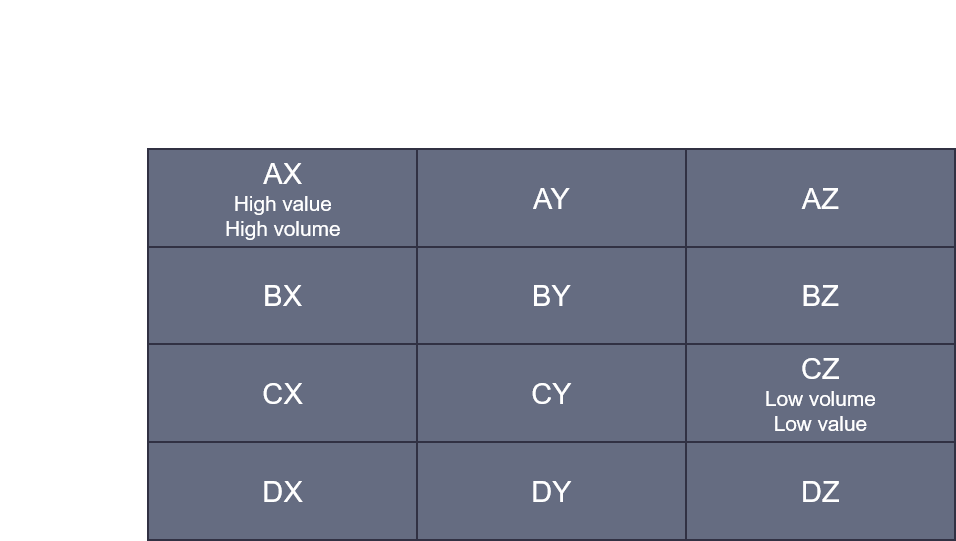Effective inventory management is fundamental to an effective supply chain. The ultimate goal of having little or no stock – all bought or assembled to order can be hard to achieve.
However, customer lead-time expectations are getting shorter than supply chain lead-time – so we need some stock.
But how much?
Different business functions drive conflicting supply chain aspirations and tensions.
So, how do we manage these conflicting challenges?
We need to identify accurate demand levels, order frequency, stock turn and stockholding so we can start to understand how to resolve these conflicts.
The answer will confirm what the optimal inventory profile could be. Understanding customer demand allows us look at options for manufacturing operations and procurement.
How to understand demand – A typical analysis can tell us where our focus will create the biggest benefit.

(AX = highest sales and demand. DZ = lowest. We can also run this analysis by inventory value and demand to identify excess stock holding).
Understanding how to tune different components of the supply chain can help confirm how we achieve the balance between Sales, Manufacturing, Procurement and Finance objectives.

A critical part of delivering the optimum position is for sales, manufacturing, procurement and finance to agree with the opportunity and to work together to deliver it.
Questions like
Of course the other key factor is the customer.
Establishing customer requirements involves sales and the customer. Customers don’t always want everything immediately. Customer product requirements and choice should be jointly reviewed to establish what is required and how quickly.
The demand profile we create in Step 1 provides a basis the discussion between sales and the customer about range, order type and cost for the business.
At a global building products supplier, we identified the products that must be available and customer delivery expectations. We looked at minimum order quantities because manufacturing and procurement batch sizes were much greater than the minimum customer order quantity. This was driving a high level of dormant inventory, with a shelf life that was driving disposal and stock loss costs.
We agreed the products that should be stocked and those that can be MTO. But we also increased the customer order size and reduced the manufacturing batch size to the minimum available.
Result – Same customer service – lower stock level.
We also optimised the distribution of the stock, holding lower levels at small branches, centralising the stock and established a regular branch replenishment cycle.
Result – Better customer service – lower stock.
Now we understand demand requirements and have changed some stocking policies –
How do we decide how much stock to hold?
Demand is generally variable based on changing customer demand, seasonality, fashion, etc. Demand is best explained by the typical supply and demand graph as shown below

Inventory held for an item can be considered as having two elements:
Cycle stock
This is the stock consumed between deliveries. For example:
Average weekly demand = 10 units
Supply Leadtime = 4 weeks
Cycle stock order requirement = 4 x 10 =40. If demand is consistent that is all that is required.
This would mean an average stock holding over the supply/demand period of 40/2 = 20.
Safety Stock
Demand is rarely consistent, this could be driven by forecasting issues, seasonal considerations, changing customer tastes, supply issues from supplier failures including, transport issues.
To ensure that inventory is available to cover these eventualities there is a second component of the inventory calculation, the safety stock. For example:
Demand will continually change and it is therefore important to develop and implement a system that continually monitors demand and adjusts both elements of inventory to represent the changing environment.
The puzzle so far:
The opportunity to re-define your inventory holding can be significant and requires a structured approach. Ensuring customer service goals are met or exceeded within financial requirements must be achieved as well.
Simply stopping ordering stock is not sustainable.